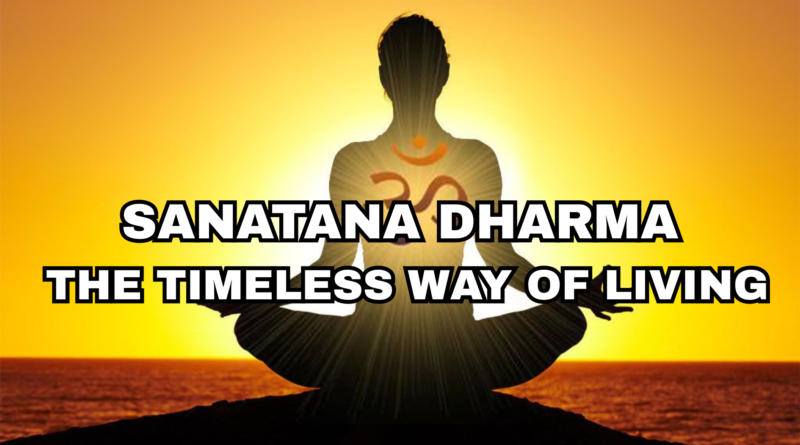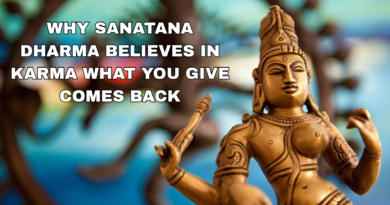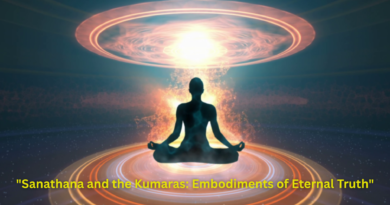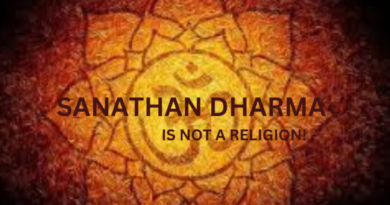SANATANA DHARMA: THE TIMELESS WAY OF LIVING
Sanatana Dharma, often called the “eternal way of life,” is one of the world’s oldest spiritual traditions. It is not just a religion but a way of living that teaches people how to live in harmony with themselves, others, and the universe. The word “Sanatana” means eternal, and “Dharma” means duty, law, or the right way of living. Together, Sanatana Dharma points to a path that is timeless, universal, and relevant for all people, regardless of age or culture.
Not Just a Religion, But a Way of Life
Sanatana Dharma is often identified with Hinduism, but it is broader than that. It does not have a single founder, a fixed date of beginning, or just one holy book. Instead, it is a collection of knowledge, wisdom, and practices passed down over thousands of years. Its aim is not only to worship God but also to guide human beings in living a meaningful and balanced life.
The principles of Sanatana Dharma can be applied to daily life. It shows how to live with truth, non-violence, compassion, and respect for nature. It encourages every person to search for inner peace and ultimate truth.
The Core Values of Sanatana Dharma
At the heart of Sanatana Dharma are values that help people live better lives. Some of the most important ones are:
Truth (Satya): Always speak and follow the truth.
Non-violence (Ahimsa): Do not harm any living being in thought, word, or action.
Purity (Shaucha): Keep the mind, body, and environment clean.
Compassion (Daya): Be kind and helpful to others.
Self-control (Dama): Learn to control desires and emotions.
Respect for Nature: See all forms of life as sacred and part of the divine.
These values are timeless. Whether someone lives in the past, present, or future, these teachings remain helpful and relevant.
The Four Goals of Life
Sanatana Dharma gives a clear vision of what life is about through the four Purusharthas or goals of human life:
Dharma (Duty and righteousness): Doing what is right and fulfilling one’s responsibilities.
Artha (Wealth and prosperity): Earning and using wealth in a fair and balanced way.
Kama (Desires and pleasures): Enjoying life’s pleasures in moderation, without harming others.
Moksha (Liberation): The ultimate freedom of the soul from the cycle of birth and death.
These four goals show that life is not just about earning money or seeking pleasure, but also about doing good and moving toward spiritual freedom.
The Concept of Karma and Rebirth
Sanatana Dharma teaches that every action has a result, which is known as karma. Good actions bring good results, while bad actions bring suffering. This law of cause and effect applies not only in this life but also in future lives.
The belief in rebirth explains that the soul (Atman) is eternal and takes birth again and again until it reaches liberation (Moksha). This encourages people to live responsibly, knowing that their choices today will shape their future.
The Pathways to Liberation
Different people have different natures, so Sanatana Dharma provides multiple paths to reach the highest truth. These include:
Bhakti Yoga (Path of devotion): Loving and surrendering to God with faith.
Karma Yoga (Path of action): Doing one’s duty without selfish attachment to results.
Jnana Yoga (Path of knowledge): Seeking wisdom and understanding the true nature of reality.
Raja Yoga (Path of meditation): Disciplining the mind and body to experience inner peace and union with the divine.
These paths give freedom to choose the way that suits one’s personality and stage of life.
Respect for Diversity
A unique feature of Sanatana Dharma is its acceptance of diversity. It teaches that there are many paths to reach God, just as there are many rivers that flow into the same ocean. This idea has helped create a culture of tolerance and respect for different beliefs.
Connection with Nature
Sanatana Dharma sees the divine in every aspect of nature. The sun, rivers, mountains, trees, and animals are all considered sacred. This has led to traditions like worshiping rivers, protecting animals like cows, and celebrating festivals that honor the cycles of nature. In modern times, this ecological wisdom is highly relevant as the world faces climate change and environmental problems.
The Timeless Relevance of Sanatana Dharma
Even though Sanatana Dharma is thousands of years old, its teachings are still useful today. In a world full of stress, conflict, and materialism, its values of peace, compassion, and balance can guide people toward happier and healthier lives.
For example:
Its focus on meditation and yoga helps reduce stress and improve mental health.
Its principle of non-violence can inspire peaceful solutions to conflicts.
Its respect for nature supports sustainable living.
Conclusion
Sanatana Dharma is more than rituals and traditions. It is a timeless way of living that teaches truth, harmony, and balance. It reminds us that life is not only about material success but also about spiritual growth and compassion. By following its eternal values, people can find inner peace, contribute to society, and live in harmony with the universe.
Sanatana Dharma is not just for one community or one country. It is a universal path that belongs to humanity as a whole. That is why it is called “Sanatana,” the eternal, and “Dharma,” the right way of living. It is truly a timeless guide for living a meaningful life.




